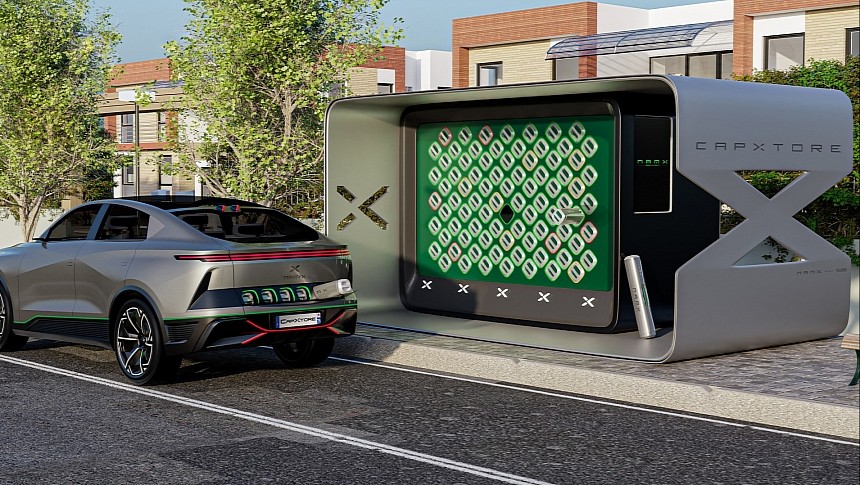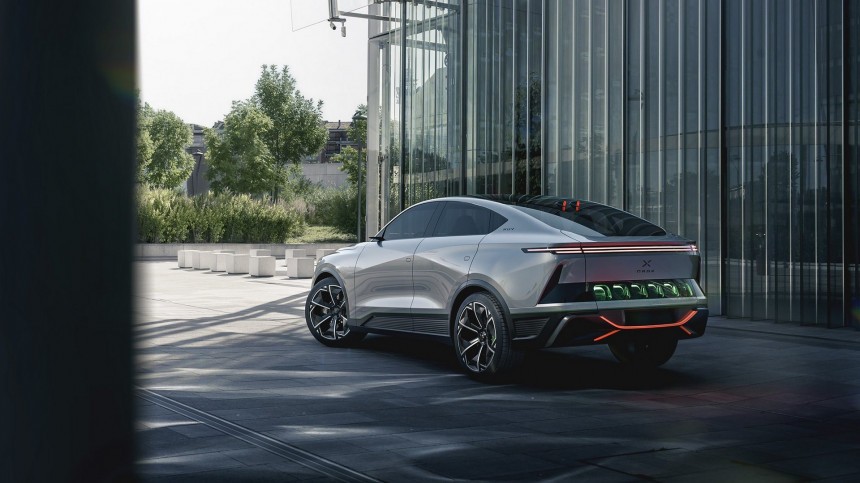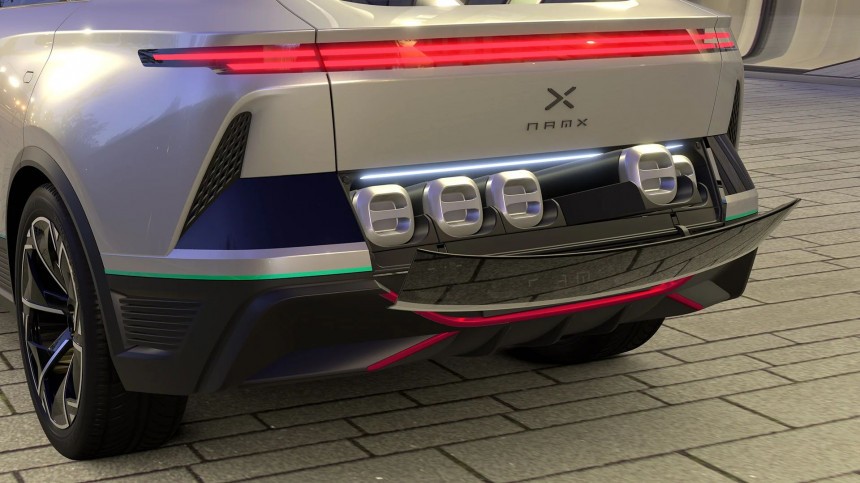When I first wrote about NamX and its SUV powered by fuel cells – the HUV – the startup said CapXs would provide hydrogen for its vehicles. These hydrogen capsules could be recharged at hydrogen stations, delivered to customers, or bought everywhere in CapX stores. With NamX about to present the HUV at the Goodwood Festival of Speed, I learned that we do not write CapX stores: it is CapXtores, as you can see in the image above.
The CapXtore will be the main news about the startup and its fuel-cell SUV. Have a good look at it, and you will say it looks familiar. That's because it looks like a fancy version of a Gogoro battery-swapping station. Gogoro became the standard for swappable battery packs in motorcycles and even tuk-tuks in the markets where it is available. Even the CapXs are similar to the Taiwanese swappable batteries – and that is not the only similarity they present. Gogoro states each swap takes only 6 seconds to happen, which is only a second more than what NamX said that replacing each hydrogen bottle demands (5 seconds).
When the startup exited stealth mode, it said the six CapXs worked as "secondary tanks," meaning the HUV had another hydrogen storage system. Now, the company is saying that the HUV "features a series of six hydrogen capsules in the rear of the car, providing an impressive range of 700 (435) to 800 kilometers (497 miles)." The way the company stated this could give the impression that the CapXs alone do that, but that is not the case.
NamX clarified that the hydrogen tank in the vehicle holds 5 kilograms (11 pounds) of the gas. The bottles provide 3 kg (6.6 lb) more, which implies each CapX carries 500 grams (1.1 lb) of hydrogen. If the HUV can run 800 km with 8 kg (17.6 pounds) of the gas, that means each kilogram provides 100 km (62 mi) of range, and each capsule extends it by 50 km (31.1 mi). They are stored under a glass cover below the back door and over the rear bumper, which is something that should be restricted to the HUV concept car. A glass component sitting right above a bumper may look good, but it is an awful idea in a production vehicle.
Just for you to have an idea of what these 8 kg represent, the three Mirai tanks hold 5.6 kg (12.35 lb) of hydrogen, which give it a range of 650 km (403.9 mi). That means the Toyota is more efficient, which is not surprising considering it is a sedan and the NamX HUV is an SUV – with a much larger frontal area and possibly a worse drag coefficient as well.
It is not clear if the CapXtores will just replace depleted hydrogen bottles or if they will also refill the returned ones with green hydrogen. That would make the resemblance to Gogoro even more complete but would require an electrolyzer, a powerful pump, and a green energy supply. Solar panels would only provide part of the electricity consumption the CapXtores have, so the company will have to ensure the electricity it uses comes from a renewable source. Another possibility is that the stations just have big hydrogen tanks that can transfer the gas to the CapXs stored at the CapXtore. NamX must have taken severe safety precautions: considering the high pressure at which these capsules work and how they are placed in lateral niches, any leaks could turn them into high-speed projectiles.
In Goodwood, NamX will tell visitors that it plans to build 4,000 CapXtores in Europe, which will be located in supermarkets, car parks, petrol stations, and at NamX dealerships. Apparently, the company intends to sell its vehicles as legacy automakers do, even if it is already taking €1,000 deposits ($1,088 at the current exchange rate) for preorders on its website. They are not fully refundable: NamX will retain 15% of that value as a "processing fee."
Deliveries will no longer happen in Q4 2025, as the company said they would in May 2022. The new date is Q1 2026, which is a slight delay if you remember the many unfulfilled promises these startups and some big companies often make. The company now disclosed that the entry-level version of the HUV will be called GT. The price remains the same: €65,000 ($70,733) for an RWD vehicle with 800 km of range, 300 hp, a governed top speed of 200 kph (124 mph), and a 0-to-100 kph (0-62 mph) acceleration time of 6.5 seconds. The GTH represents an upgrade in the 0-to-100 kph acceleration (4.5 s), top speed (250 kph, or 155 mph), traction (AWD), and price: it will cost €95,000 ($103,379).
Although Pininfarina is involved, NamX still has to prove it can deliver the CapXtores, CapXs, and HUVs. It still has to clarify how many units of the 2022 Historic Edition will be available, if it will manufacture the cars on its own or through a manufacturing contractor, who will supply the fuel cells, and several other details about its operation. NamX has the opportunity to establish a standard for hydrogen distribution with its capsule stations, just like Gogoro did. As promising as that all is, it also means that delivering the vehicles is just part of what the company has to sort out. I'd only put down any money to get in line for the HUV after seeing CapXtores around and the first SUV swapping capsules there. Goodwood does not count.
When the startup exited stealth mode, it said the six CapXs worked as "secondary tanks," meaning the HUV had another hydrogen storage system. Now, the company is saying that the HUV "features a series of six hydrogen capsules in the rear of the car, providing an impressive range of 700 (435) to 800 kilometers (497 miles)." The way the company stated this could give the impression that the CapXs alone do that, but that is not the case.
NamX clarified that the hydrogen tank in the vehicle holds 5 kilograms (11 pounds) of the gas. The bottles provide 3 kg (6.6 lb) more, which implies each CapX carries 500 grams (1.1 lb) of hydrogen. If the HUV can run 800 km with 8 kg (17.6 pounds) of the gas, that means each kilogram provides 100 km (62 mi) of range, and each capsule extends it by 50 km (31.1 mi). They are stored under a glass cover below the back door and over the rear bumper, which is something that should be restricted to the HUV concept car. A glass component sitting right above a bumper may look good, but it is an awful idea in a production vehicle.
It is not clear if the CapXtores will just replace depleted hydrogen bottles or if they will also refill the returned ones with green hydrogen. That would make the resemblance to Gogoro even more complete but would require an electrolyzer, a powerful pump, and a green energy supply. Solar panels would only provide part of the electricity consumption the CapXtores have, so the company will have to ensure the electricity it uses comes from a renewable source. Another possibility is that the stations just have big hydrogen tanks that can transfer the gas to the CapXs stored at the CapXtore. NamX must have taken severe safety precautions: considering the high pressure at which these capsules work and how they are placed in lateral niches, any leaks could turn them into high-speed projectiles.
In Goodwood, NamX will tell visitors that it plans to build 4,000 CapXtores in Europe, which will be located in supermarkets, car parks, petrol stations, and at NamX dealerships. Apparently, the company intends to sell its vehicles as legacy automakers do, even if it is already taking €1,000 deposits ($1,088 at the current exchange rate) for preorders on its website. They are not fully refundable: NamX will retain 15% of that value as a "processing fee."
Although Pininfarina is involved, NamX still has to prove it can deliver the CapXtores, CapXs, and HUVs. It still has to clarify how many units of the 2022 Historic Edition will be available, if it will manufacture the cars on its own or through a manufacturing contractor, who will supply the fuel cells, and several other details about its operation. NamX has the opportunity to establish a standard for hydrogen distribution with its capsule stations, just like Gogoro did. As promising as that all is, it also means that delivering the vehicles is just part of what the company has to sort out. I'd only put down any money to get in line for the HUV after seeing CapXtores around and the first SUV swapping capsules there. Goodwood does not count.



























